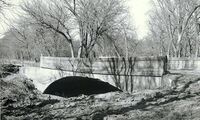NRHP: Big Blue River Bridge, Grafton
Contents
Big Blue River Bridge
NRHP Reference #: 92000745
NRHP Listing Date: 19920629
Location
6 mi NW of Grafton, Fillmore County, Nebraska
View this property's location
View all NRHP properties on this map.
Summary
After some initial experimentation with concrete bridge construction in the early 1900s, Fillmore County built concrete arch and slab spans almost exclusively from 1914 through the 1920s. The state engineer appears to have been largely responsible for the county's acceptance of concrete. The state was a major proponent of concrete, touting it as a more durable alternative to steel. Fillmore County relied on state bridge plans until 1918, when William A. Biba became county engineer. Biba appears to have designed all of the county's bridges until 1931, using state plans as a model. Designed in 1918, this fifty-foot concrete arch was apparently one of Biba's first bridges. It was built that year by Exeter, Nebraska, contractor Frank Craven. The Big Blue River Bridge represents early concrete bridge construction in Nebraska.
Further Information
Bibliography
About the National Register of Historic Places
The National Register of Historic Places (NRHP) is the country’s official list of historically significant properties. To be eligible for the NRHP a property must generally retain their historic appearance, be at least 50 years old, and have the potential to be documented as historically or architecturally significant at either the local, state, or national level. The National Register of Historic Places is a National Park Service program administered by the Nebraska State Historical Society for the state of Nebraska. Visit the Nebraska State Historical Society's website to learn more about the program.
